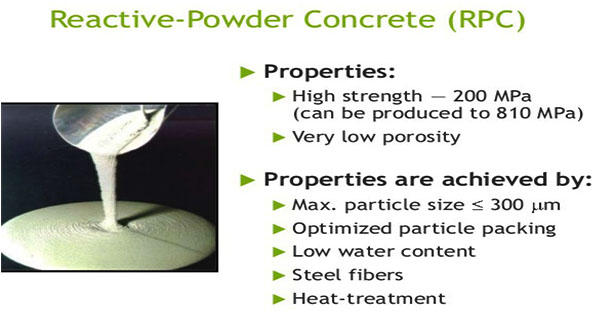Brief overview of Reactive Powder Concrete (RPC)

Reactive Powder Concrete (RPC) stands for an evolving composite material that will improve the concrete properties to make the use of material superior. Besides, the cost will also be reduce and strong & durable structures will be developed. RPC offers superior strength (both compressive and flexural) and lesser permeability compared to HPC.
Reactive Powder Concrete (RPC) belongs to an ultra high-strength and high ductility cementitious that is built with advanced mechanical and physical properties.
RPC is formed with very fine powders like cement, sand, quartz powder and silica fume as well as steel fibres (optional) and superplasticizer. Quarts are applied in place of ordinary aggregate to enhance the compressive strength. The superplasticizer, if applied at its optimum dosage, reduces the water to cement ratio (w/c) whereas enhancing the performance of the concrete. A very dense matrix can be obtained by improving the granular packing of the dry fine powders. This solidity provides ultra-high strength and sturdiness to RPC. Reactive Powder Concretes contain compressive strengths fluctuating from 200 MPa to 800 MPa.
RPC is microstructurally improved through heat curing. Heat curing is done by just heating (normally at 90°C) the concrete at normal pressure once it is set perfectly. This significantly speeds up the pozzolanic reaction, whereas altering the microstructure of the hydrates that is produced. Pre-setting pressurization is also recommended for obtaining superior strength.
Due to extreme strength, RPC becomes greatly brittle. Therefore, steel fibres are included to RPC to optimize its ductility. Normally, straight steel fibres having 13 mm length and a diameter of 0.15 mm are used. The fibres are presented into the mixture at a ratio of among 1.5 and 3% by volume. The economical optimal dosage is similar to a ratio of 2% by volume, or around 155 kg/m3.
The RPC family includes two types of concrete, designated RPC 200 and RPC 800, which offer interesting implicational possibilities in different areas. Mechanical properties for the two types of RPC are given in Table 4. The high flexural strength of RPC is due to the addition of steel fibres.
RPC has ultra-high durability characteristics resulting from its extremely low porosity, low permeability, limited shrinkage and increased corrosion resistance.
COMPOSITION
- It is formed with similar modulus of elasticity and size which enhance consistency and minimize differential tensile strain.
- Among the materials, sand contains the greatest particle size in RPC.
- As the density will be higher, there will be more strength & less permeability.
- Water cement ratio in RPC varies from 0.15 to 0.25
- There is more strength than 200MPa attained, cured at 90 degree Celsius.
COMPONENTS WITH FUNCTIONS PARAMETERS
COMPONENTS
- Sand
- Cement
- Quartz powder
- Silica fume
- Steel fibers
- Superplasticiser
Function parameters
- Provide enough strength to aggregate
- Bond material
- Extreme reactivity throughout the heat-treating
- Filling the voids
- Enhance ductility
- Minimize water binding
PROPERTIES OF RPC
1. COMPRESSIVE STRENGTH
- Greater compressive strength as compared to HPC
- It is a factor connected with stability of material.
- Optimal compressive strength of RPC is roughly 200MPa.
2. FLEXTURAL STRENGTH
- Plane RPC contains high flextural strength as compared to HPC
- RPC obtains greater flextural strength with steel fibers.
To gather more information, go through the following link
www.engineersdaily.com

